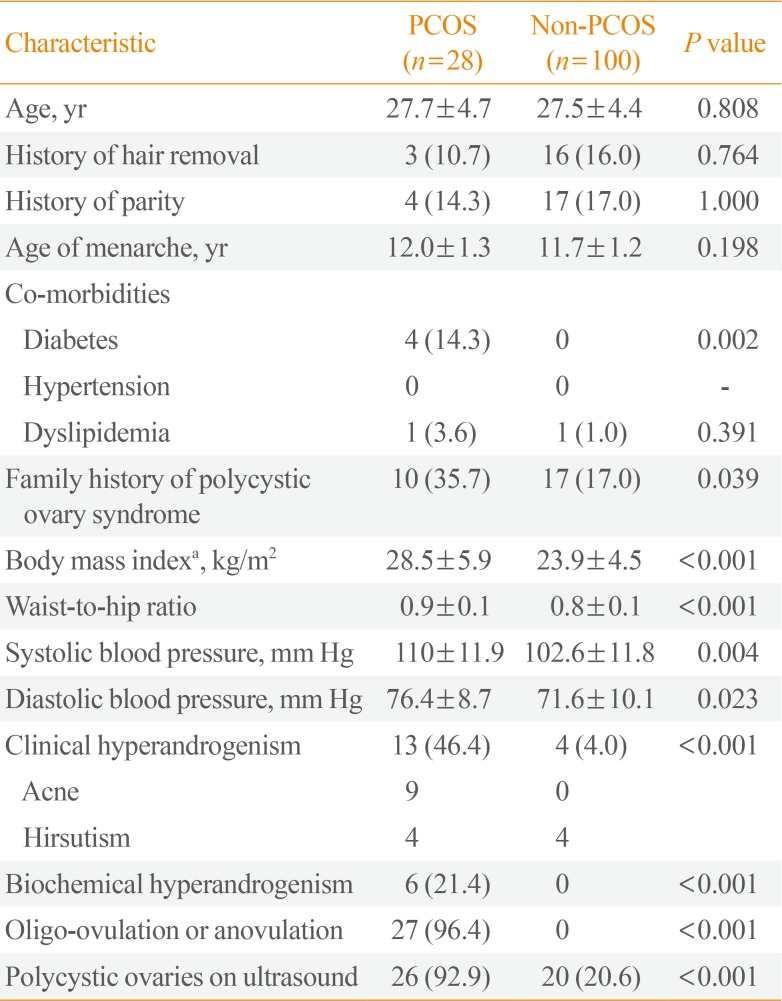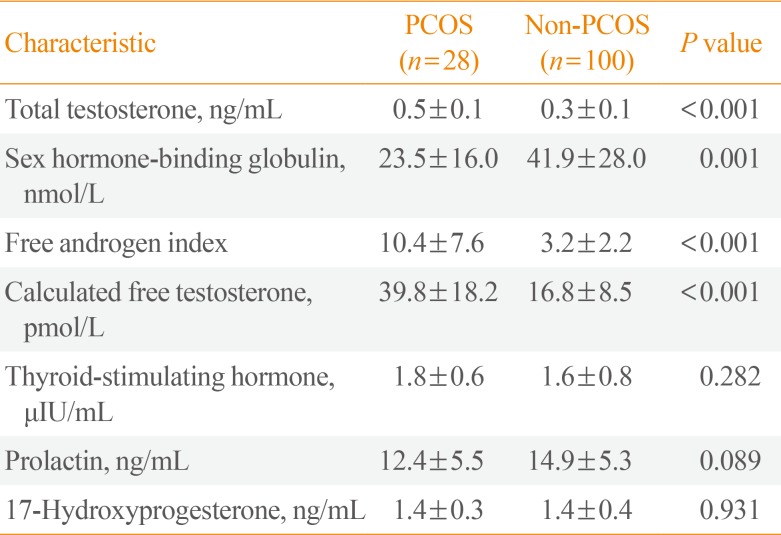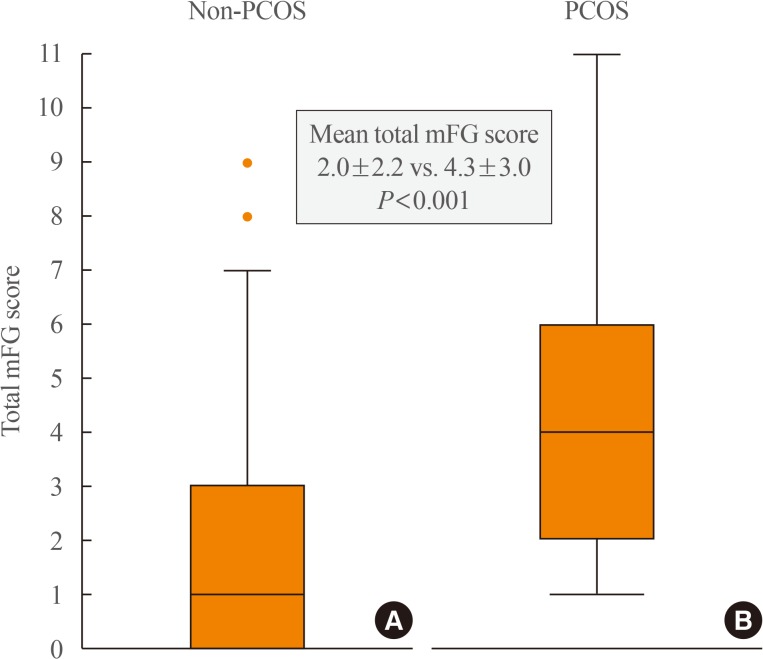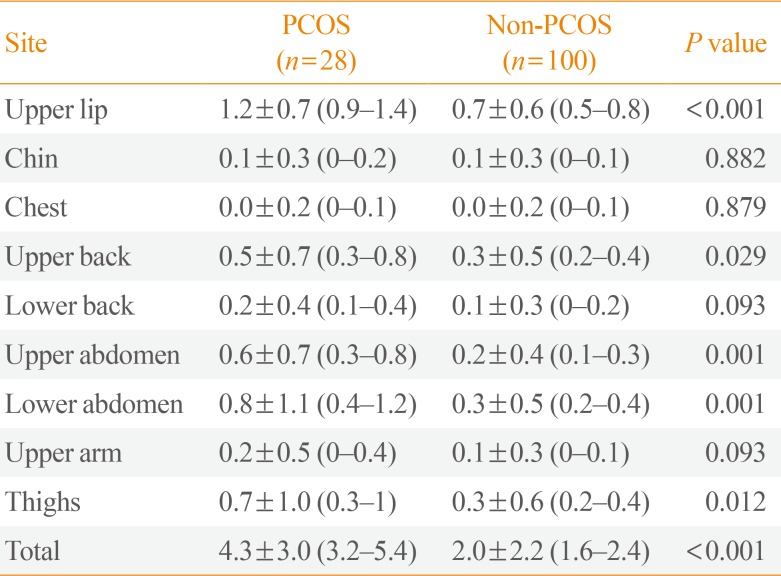1. Afifi L, Saeed L, Pasch LA, Huddleston HG, Cedars MI, Zane LT, et al. Association of ethnicity, Fitzpatrick skin type, and hirsutism: a retrospective cross-sectional study of women with polycystic ovarian syndrome. Int J Womens Dermatol. 2017; 3:37–43. PMID:
28492053.

2. Azziz R, Woods KS, Reyna R, Key TJ, Knochenhauer ES, Yildiz BO. The prevalence and features of the polycystic ovary syndrome in an unselected population. J Clin Endocrinol Metab. 2004; 89:2745–2749. PMID:
15181052.

3. Martin KA, Anderson RR, Chang RJ, Ehrmann DA, Lobo RA, Murad MH, et al. Evaluation and treatment of hirsutism in premenopausal women: an Endocrine Society Clinical Practice Guideline. J Clin Endocrinol Metab. 2018; 103:1233–1257. PMID:
29522147.

4. Legro RS, Arslanian SA, Ehrmann DA, Hoeger KM, Murad MH, Pasquali R, et al. Diagnosis and treatment of polycystic ovary syndrome: an Endocrine Society Clinical Practice Guideline. J Clin Endocrinol Metab. 2013; 98:4565–4592. PMID:
24151290.

5. Carmina E, Rosato F, Janni A, Rizzo M, Longo RA. Extensive clinical experience: relative prevalence of different androgen excess disorders in 950 women referred because of clinical hyperandrogenism. J Clin Endocrinol Metab. 2006; 91:2–6.
6. Sirmans SM, Pate KA. Epidemiology, diagnosis, and management of polycystic ovary syndrome. Clin Epidemiol. 2013; 6:1–13. PMID:
24379699.

7. Hatch R, Rosenfield RL, Kim MH, Tredway D. Hirsutism: implications, etiology, and management. Am J Obstet Gynecol. 1981; 140:815–830. PMID:
7258262.

8. Ferriman D, Gallwey JD. Clinical assessment of body hair growth in women. J Clin Endocrinol Metab. 1961; 21:1440–1447. PMID:
13892577.

9. Escobar-Morreale HF, Carmina E, Dewailly D, Gambineri A, Kelestimur F, Moghetti P, et al. Epidemiology, diagnosis and management of hirsutism: a consensus statement by the Androgen Excess and Polycystic Ovary Syndrome Society. Hum Reprod Update. 2012; 18:146–170. PMID:
22064667.

10. Wang ET, Kao CN, Shinkai K, Pasch L, Cedars MI, Huddleston HG. Phenotypic comparison of Caucasian and Asian women with polycystic ovary syndrome: a cross-sectional study. Fertil Steril. 2013; 100:214–218. PMID:
23557763.

11. Leerasiri P, Wongwananuruk T, Indhavivadhana S, Techatraisak K, Rattanachaiyanont M, Angsuwathana S. Correlation of clinical and biochemical hyperandrogenism in Thai women with polycystic ovary syndrome. J Obstet Gynaecol Res. 2016; 42:678–683. PMID:
26890011.

13. Su HW, Chen CM, Chou SY, Liang SJ, Hsu CS, Hsu MI. Polycystic ovary syndrome or hyperprolactinaemia: a study of mild hyperprolactinaemia. Gynecol Endocrinol. 2011; 27:55–62. PMID:
20504100.

14. Li R, Qiao J, Yang D, Li S, Lu S, Wu X, et al. Epidemiology of hirsutism among women of reproductive age in the community: a simplified scoring system. Eur J Obstet Gynecol Reprod Biol. 2012; 163:165–169. PMID:
22748844.

15. Vermeulen A, Verdonck L, Kaufman JM. A critical evaluation of simple methods for the estimation of free testosterone in serum. J Clin Endocrinol Metab. 1999; 84:3666–3672. PMID:
10523012.

16. Nadaraja RND, Sthaneshwar P, Razali N. Establishing the cut off values of androgen markers in the assessment of polycystic ovarian syndrome. Malays J Pathol. 2018; 40:33–39. PMID:
29704382.
17. Karimah P, Hestiantoro A. The cut off of Ferriman Gallwey score for PCOS in Asia and the degree of hyperandrogenism indicator. In : Malhotra J, Lunenfeld B, Tzeng CR, editors. The 6th Congress of the Asia Pacific Initiative on Reproduction (ASPIRE 2016) KnE Medicine; 2016 Apr 8–10; Jakarta, ID. Dubai: Knowledge E;2016. p. 186–192.
18. Kim JJ, Chae SJ, Choi YM, Hwang SS, Hwang KR, Kim SM, et al. Assessment of hirsutism among Korean women: results of a randomly selected sample of women seeking pre-employment physical check-up. Hum Reprod. 2011; 26:214–220. PMID:
21098626.

19. Cheewadhanaraks S, Peeyananjarassri K, Choksuchat C. Clinical diagnosis of hirsutism in Thai women. J Med Assoc Thai. 2004; 87:459–463. PMID:
15222512.
20. Yildiz BO, Bolour S, Woods K, Moore A, Azziz R. Visually scoring hirsutism. Hum Reprod Update. 2010; 16:51–64. PMID:
19567450.

21. Pacioles-Flavier CMH, Aguilar AS. A cross-sectional study of patients with polycystic ovary syndrome consulting at a tertiary hospital from February–July 2004. Philipp J Reprod Endocrinol Infertil. 2007; 4:1–6.











 PDF
PDF ePub
ePub Citation
Citation Print
Print



 XML Download
XML Download